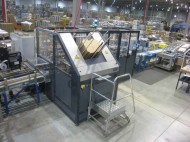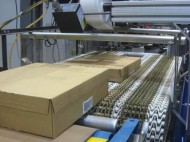 When revenues are staggering, executives start searching for new hidden costs in their business. But in the modern era of lean organizations, large scale outsourcing, and fine tuned financial analysis, cost nuggets are scarce. Business difficulties motivate managers to look in new directions where they never looked before, where for sure they are not comfortable. For retailers, packaging is such an unfamiliar direction because it sits at the crossroads of all the company departments.
When revenues are staggering, executives start searching for new hidden costs in their business. But in the modern era of lean organizations, large scale outsourcing, and fine tuned financial analysis, cost nuggets are scarce. Business difficulties motivate managers to look in new directions where they never looked before, where for sure they are not comfortable. For retailers, packaging is such an unfamiliar direction because it sits at the crossroads of all the company departments.
Certainly a shipping case is a basic thing, but it has been worked out for months by warehousing managers to decide the box sizes. It has been tested for weeks by logistics people checking that packages resist the journey through the supply chain. It has gone through the regulatory specialists who make sure that the package is compliant with all regulations. All the above has been squeezed by commodity purchasers in search of a good deal for packaging materials. Material handling specialists have designed multimillion pounds systems based on a very precise box definition. Last, most probably marketing people went through several meetings to decide the final box layout. Who would be brave enough to investigate potential saving in the packaging function ?
However, as the package concerns many departments in the company it has many functions, and as such it concentrates numerous costs elements. The beauty of cost cutting approach on the package is that there is not only one cost to work on but many. All may not provide significant savings but all combined most certainly would.
First cost to address is the box itself. The taped Fefco 0201 case has become popular worldwide and is now the only offering from suppliers. However, it has low resistance performances, it runs poorly on conveyors and looks ugly. The glued tray + lid only supported by automation addresses all these issues. And cost wise, for equivalent resistance it requires lower corrugated grade and thus costs less.
Protection of the product with traditional void fill materials such as air bags, bubble wrap, wrapped paper, or peanuts costs usually approximately as much as 50% the cost of the box itself, and protection performance is still unpredictable as it depends on the operator who inserts the void fill and the time he/she has to do it. Packaging automation like Ultipack® from B+ Equipment cuts void fill material cost by two and provides reliable product protection whatever the product shape and weight, and whatever the box filling ratio.
Security is another concern with taped boxes. Here also the glued package provided by automated solutions makes it impossible to pilfer without leaving visual evidence.
Void in transit packages is now blamed by consumers and begins to be worth significant money as carriers apply dim weighting charges even for ground transport. In the same time, multiple box sizes are not the solution because they are a nightmare to manage in the warehouse. Packaging automation like I-Pack® from B+ Equipment reduces boxes to the exact height of the products. This is a high speed on-the-fly process. Furthermore, such cube reduction process makes it possible to completely suppress all void fill for non fragile items.
 Last, packing labour remains one of the major cost elements in the warehouse. When volumes exceed a thousand boxes per day, manual packing becomes the bottleneck. Here also packaging automation is the adequate answer with typical speed of 700 boxes per hour and per line offering a payback shorter than 18 months.
Last, packing labour remains one of the major cost elements in the warehouse. When volumes exceed a thousand boxes per day, manual packing becomes the bottleneck. Here also packaging automation is the adequate answer with typical speed of 700 boxes per hour and per line offering a payback shorter than 18 months.
Besides, packaging automation provides secondary benefits like reduced floor space, automated end-of-line functions, and marketing opportunities.
B+ Equipment
Bernard Dominici
Email: b.dominici@bplus-equip.fr.




Comments are closed.